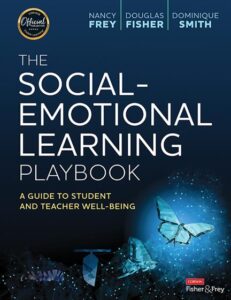A Playbook for Student and Teacher Well-Being
The Social-Emotional Learning Playbook: A Guide to Student and Teacher Well-Being
By Nancy Frey, Douglas Fisher and Dominique Smith
(Corwin, 2022 – Learn more)
Reviewed by Anne Anderson

Grounded in research and real-world situations, this resource supports the social-emotional growth in you, your students, and your community.
The Introduction is filled with background information to help readers understand the impact of adverse childhood experiences in today’s schools. The Collaborative for Academic, Social, and Emotional Learning (CASEL) has developed the most well-known framework for social emotional learning in K-12 schools.
The authors write: “The five-part framework they have developed focuses on the knowledge, skills, and dispositions young people need to learn, reach their aspirations, and be contributing members of their classroom, school, and local communities.” (p.1)

In the six modules the authors explore social-emotional skills and learning. Each module begins with pertinent background information followed by a Vocabulary Self-Awareness activity and the CASEL connections for educators, students, and schools.
The authors suggest numerous research-based actions and approaches for us, our students, and our school. Within those strategies and techniques, I see hope – hope for weary teachers, confused students, and struggling schools.
Make the most of this book! Do not skip the “Note to Self” activities; these reflective prompts are especially thought provoking. Another extremely helpful tool is “Case in Point” which provides a scenario to analyze and decide on a course of action.
From Module 1: Building on Strengths for Resilience
“Learners who work from a position of strength are more likely to learn faster and more completely.” (p.20) Be a strength-spotter! In other words, focus on what a student can do, not what they cannot do. After assessing your strengths, you are better equipped to meet the needs of your students. As I worked my way through this module, I gained confidence in spotting strengths in all aspects of my life.
From Module 2: Identities, Belonging, and Prosocial Skills
Next the authors explore how our identity and belonging are shaped by our experiences. They write about experiences that bring about belonging, and how to create a positive school identity. “Teaching students to care for and about others is not going to be accomplished with isolated lessons on kindness.” (p.55) Teachers, administrators and other adults in the building should create an intentional culture of caring and belonging. This book can help.
As educators we know a school’s reputation has an impact on learning; therefore, be sure to study the suggestions from the business world to improve your school’s identity and reputational capital.
From Module 3: Emotional Regulation
The ability to name and regulate our emotions is a life skill. Here readers find numerous practical, easy-to-use techniques to help regulate emotions for us, students, and the school. The “Note to Self” activity on pages 72-73 is my favorite; it is an extremely creative way to focus on our self-awareness.
The authors remind us that “social-emotional learning initiatives work best when applied as a school-wide approach.” (p. 85) With that goal in mind, CASEL offers an online comparison tool of programs that you might want to use if your school or district is looking for a program.
From Module 4: Relational Trust and Communication
It is critical in today’s schools to create relationships built on relational trust with students, peers and families. If you completed the Character Strength Profile in Module 1, review your signature strengths. Look for teamwork, social intelligence, leadership, judgment, and perspective as any of those will aid you in developing empathic concern.
Being responsive to the needs of a particular school community, the authors share how their California open enrollment public school developed procedures for a family safety plan should Immigration and Customs Enforcement officials detain a student’s caregiver.
From Module 5: Individual and Collective Efficacy
“When we trust the person who encourages us, we can increase our self-efficacy.” (p.124) Research suggests that low teacher efficacy is related to burnout and turnover. Begin by completing the Teachers’ Sense of Efficacy Scale and identify those actions you might need to take to build or rebuild your efficacy.
Prepare to build student confidence by setting goals together, encouraging self-assessment, giving useful feedback, emptying their heads, showing that effort is normal, and celebrating success. There are numerous other tools to teach; however, teaching students to self-assess and monitor their progress is extremely powerful.
From Module 6: A Community of Care
Now examine how to take care of yourself, how to teach students about self-care, and how to create a community of care in your building. We are reminded to invest in our own emotional well-being in order to reach out to others . . . not as a therapist, but as a listener.
As we invest in our students’ emotional well-being, consider using the validated assessment of emotional well-being for ages nine and above developed by the World Health Organization (WHO). This module is filled with emotional wellness techniques to use in the classroom. A number of small adjustments (e.g., wall color; lighting; noise; layout; or presence of nature) can improve the physical environment.
“A schoolwide commitment to fostering a community of care magnifies and multiplies the efforts of individual educators.” (p.171) And school climate has a direct influence on academic learning.
The downloadable resources are available from Corwin. Here’s a sample.
Anne Anderson always knew she wanted to be a teacher. She graduated from East Texas Baptist University with an English major and History minor and did graduate work at Louisiana State University and Louisiana Tech University. After teaching 8th graders for 24 years, Anne served as a content coach. Since retiring in 2011, Anne has worked as an educational consultant, presenting at national conferences and onsite trainings for public and private schools.
Calendar Celebrations: September, October, November is part of Anne Anderson’s trilogy on quick, engaging activities and resources for months of the school year. (For MiddleWeb she wrote about back to school and fall resources here.) Anne has also published articles in IDEAS Plus and Voices from the Middle, publications of the National Council of Teachers of English. She is a frequent reviewer of professional books for MiddleWeb.com.






























